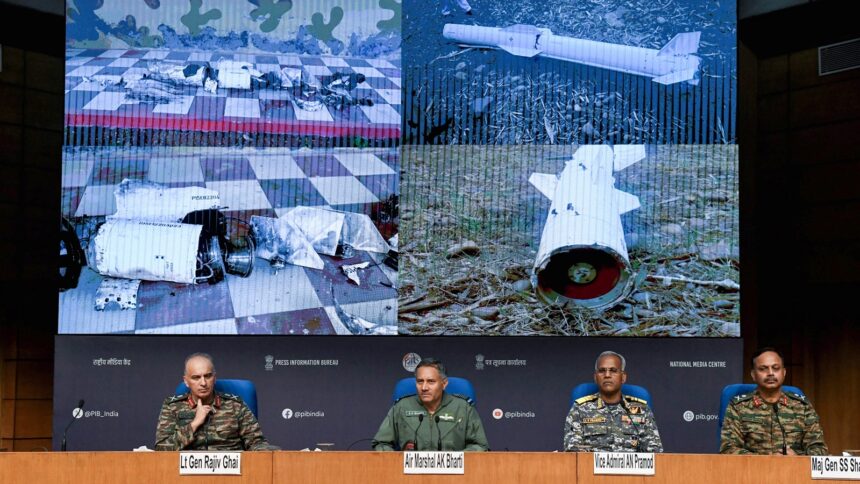For the first time since it commenced Operation Sindoor and thwarted most of Pakistan’s aerial attacks, India Monday named China-supplied weapons in the Pakistani arsenal used against the Indian Armed Forces.
Briefing the media, Air Marshal A K Bharti, Director General Air Operations, presented visual evidence of missile remnants. “You can see the pieces of it on the screen,” he said, showcasing debris of the PL-15 long range missile that fell inside Indian territory, including a relatively intact rear section recovered from Hoshiarpur, Punjab.
The Armed Forces intercepted and neutralised a range of high-tech foreign weapons used by Pakistan, including Chinese-origin PL-15 air-to-air missiles and Turkish Byker YIHA III Kamikaze drones.
The naming of China is a first in this round of India-Pakistan hostilities — all these years, New has closely tracked the expanding Sino-Pak military ties.
Sources said that China-Pakistan ties across domains — political, economic, nuclear and military — have been ongoing for decades, and Beijing has been supplying weapons to Rawalpindi.
Last week, India had only named Turkish drones as being used by Pakistan. But now it has publicly named Chinese and Turkish weapons.
The PL-15, developed by China’s Aviation Industry Corporation (AVIC), is a long-range, radar-guided missile designed to engage high-value airborne targets at ranges exceeding 200 km.
The PL-15 is China’s standard active-radar-guided AAM, and it was intended to at least match the performance of the US-made AIM-120D Advanced Medium-Range Air-to-Air Missile (AMRAAM).
Its export version, the PL-15E, is reported to have a maximum range of 145 km and is integrated with Pakistan’s JF-17 Block III and J-10CE fighters.
The domestic version in use by the Chinese military has a reported range of between 300-500 km.
On April 26, the Pakistan Air Force (PAF) released visuals of JF-17s armed with PL-15E and PL-10 missiles. Pakistan’s fleet includes an estimated 45-50 JF-17 Block IIIs and 20 J-10CEs — approximately 70 aircraft capable of deploying the PL-15E, according to Pakistan’s military.
The missile’s guidance system includes inertial navigation, Beidou satellite updates, a two-way datalink, and AESA radar terminal homing.
It features a dual-pulse solid rocket motor and can reach speeds exceeding Mach 5. The warhead, typically high-explosive fragmentation, weighs between 20 to 25 kg.
The weapon may have been sourced directly from China’s People’s Liberation Army Air Force (PLAAF).
Both countries jointly manufacture the J-17 aircraft, the mainstay of the PAF.
The Indian military’s statement on the PL-15 is significant, coming two days after an understanding withPakistan to stop all military actions.
On May 10, the Chinese Foreign Ministry said NSA Ajit Doval spoke to Chinese State Councillor Wang Yi.
“Doval said that the Pahalgam terrorist attack caused serious casualties… and that India needed to take counter-terrorism actions. War was not India’s choice and was not in the interests of any party. India and Pakistan would be committed to a ceasefire and look forward to restoring regional peace and stability as soon as possible,” the Chinese Foreign Ministry said.
“Wang Yi said China condemns the Pahalgam terrorist attack and opposes all forms of terrorism. The current international situation is turbulent and intertwined. Peace and stability in the Asian region is hard-won and deserves to be cherished. India and Pakistan are neighbours that cannot be moved away, and both are neighbours of China. China appreciates your statement that war is not India’s choice, and sincerely hopes that India and Pakistan will remain calm and restrained, properly handle differences through dialogue and consultation, and avoid escalation of the situation. China supports and expects India and Pakistan to achieve a comprehensive and lasting ceasefire through consultations. This is in the fundamental interests of India and Pakistan and is also the common wish of the international community,” it said.
For Delhi to single out Beijing sends a signal to the Chinese leadership on its role in the hostilities between India and Pakistan, at a time when China said it will play a constructive role to bring about a ceasefire between India and Pakistan. China and Pakistan had played a role in watering down the UN Security Council statement on the Pahalgam terror attack – it did not name The Resistance Front which had initially claimed responsibility for the terror attack in which 26 civilians were killed.








